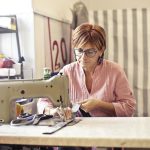Are you tired of hand-sewing hems and edges on your clothing? Look no further than a blind stitch sewing machine.
This handy tool is designed to create nearly invisible stitches that are perfect for hemming pants, skirts, and other garments. A blind stitch sewing machine works by using a special needle and thread to create a series of small, nearly invisible stitches that secure your fabric without being noticeable on the outside.
This makes it perfect for projects where you want the seam to be hidden, such as when hemming a pair of dress pants. But the uses for a blind stitch sewing machine don’t stop there. Keep reading to learn more about how this versatile tool can help you with all your sewing needs.
Table of Contents
How Blind Stitch Sewing Machines Work
So, you’re probably wondering how the heck a blind stitch sewing machine actually works, right?
Well, let me break it down for you. A blind stitch sewing machine is designed to create a nearly invisible hem on fabric, so it’s perfect for making pants, skirts, and dresses.
The machine works by using a special stitch that catches only a few threads on the outside of the fabric, while most of the stitching is hidden on the inside.
The secret to a blind stitch sewing machine is the adjustable guide that holds the fabric in place. As you feed the fabric through the machine, the guide adjusts to the thickness of the fabric and creates the perfect stitch.
The machine also has a special foot that helps to hold the fabric in place and keep it from shifting while you sew.
One of the best things about a blind stitch sewing machine is how quick and easy it is to use. Once you get the hang of it, you can hem a pair of pants or a skirt in just a few minutes.
Plus, the finished hem looks professional and polished, so you can feel confident wearing your handmade clothes out in public.
The Advantages of Using a Blind Stitch Sewing Machine
Using a blind stitch sewing machine has many benefits that make it a popular choice among tailors and seamstresses. One of the biggest advantages is the ability to create a nearly invisible hem. This is especially useful when working with delicate fabrics or garments that require a professional finish.
The machine uses a special stitch that tucks the thread under the fabric, leaving only small, almost invisible stitches on the outside. Another advantage of using a blind stitch sewing machine is the speed at which it can complete a hem. With the ability to sew quickly and efficiently, tailors and seamstresses can finish projects faster and move on to the next one.
This is especially important for those who work in high-volume environments, such as production lines or alterations shops. Using a blind stitch sewing machine can save time and money in the long run. Because of its precision and efficiency, it reduces the need for costly repairs or alterations down the line.
This means that garments will last longer and require fewer touch-ups, ultimately saving both time and money for both the tailor and the customer. Overall, the benefits of using a blind stitch sewing machine make it an excellent investment for any sewing professional.
How to Use a Blind Stitch Sewing Machine
First, you’ll need to prepare the blind stitch sewing machine for use by threading it and ensuring it’s in good working condition.
Next, choose the right needle and thread for your fabric to ensure a quality finish.
Finally, adjust the machine settings for different fabrics, such as adjusting the stitch length and tension.
By following these steps, you’ll be able to use your blind stitch sewing machine effectively and efficiently.
Preparing the Machine for Use
Before starting, make sure the blind stitch sewing machine is properly set up and adjusted to avoid any potential issues during use. Here are some steps you can follow to get the machine ready for use:
-
First, make sure the machine is clean and free of any debris or dust. This will prevent any clogs or jams from occurring during use.
-
Next, adjust the tension settings according to the thickness of the fabric you’ll be working with. This’ll ensure that the stitches are even and secure.
-
Finally, thread the machine properly and test it out on a scrap piece of fabric to ensure everything’s working correctly before starting on your actual project.
By taking the time to properly prepare the machine for use, you can avoid any frustration or issues that may arise during the sewing process. So, take a few extra minutes to get everything set up correctly, and you’ll be ready to create beautifully finished seams with your blind stitch sewing machine.
Choosing the Right Needle and Thread
To get the best results with your project, you need to choose the right needle and thread for your material. Using the wrong needle or thread can cause your stitches to break or not hold properly, which can ruin your project.
When selecting a needle, consider the weight and type of fabric you’ll be using. A heavier fabric will require a thicker needle, while a lighter fabric will require a thinner needle. You should also consider the type of thread you’ll be using. Cotton thread is typically used for natural fibers, while polyester thread is better for synthetic fabrics.
It’s important to note that a blind stitch sewing machine uses a special needle and thread for its unique stitch. The needle has a small hook on the side that catches the thread and pulls it through the fabric, creating a nearly invisible stitch. The thread used for this stitch is typically a finer weight than what would be used for a regular sewing machine.
By choosing the right needle and thread, you can ensure that your blind stitch sewing machine produces the best results for your project.
Adjusting the Machine for Different Fabrics
You can easily adjust your machine to accommodate different fabrics, ensuring a smooth and frustration-free sewing experience. First, adjust the presser foot pressure. This controls how hard the presser foot holds the fabric against the feed dogs. For lightweight fabrics, decrease the pressure to prevent the fabric from puckering or stretching. For heavier fabrics, increase the pressure to feed the fabric evenly.
Second, adjust the stitch length. This determines the distance between each stitch. For delicate fabrics, use a shorter stitch length to prevent the fabric from fraying or tearing. For thicker fabrics, use a longer stitch length to make sure the seams are strong enough to hold the fabric together.
By taking the time to adjust your machine for each fabric, you’ll not only improve the quality of your sewing, but also extend the life of your machine.
Tips for Maintaining Your Blind Stitch Sewing Machine
Proper maintenance is crucial for keeping your blind stitch sewing machine in top condition. Here are some tips to help you maintain your machine:
-
Clean the machine after every use. Use a soft brush to remove lint and dust from the bobbin area and the feed dog. You can also use a lint roller to remove any stray threads or fabric bits. This will prevent the accumulation of debris that can cause your machine to malfunction or break down.
-
Oil the machine regularly. Apply a drop or two of oil to the moving parts of the machine, such as the needle bar, bobbin case, and hook race. Refer to your machine manual for specific instructions on oiling your machine. Oiling keeps the machine running smoothly and reduces wear and tear on the parts.
-
Check the tension and stitch length regularly. Incorrect tension or stitch length can lead to uneven stitching or even thread breakage. Make sure that the tension is set correctly for the fabric you’re working with and adjust the stitch length as needed. It’s also a good idea to test the stitching on a scrap piece of fabric before starting your project.
By following these simple tips, you can ensure that your blind stitch sewing machine stays in good working order for years to come. Regular maintenance will not only extend the life of your machine but it’ll also improve the quality of your sewing projects. So, take the time to care for your machine and enjoy hassle-free sewing!
Other Uses for Blind Stitch Sewing Machines
Get creative with your fabric projects by exploring the various functions and capabilities of this versatile piece of equipment! While a blind stitch sewing machine is primarily used for hemming pants, skirts, and dresses, it can be used for other purposes as well. Here are some ideas to help you expand your sewing horizons:
First, consider using a blind stitch sewing machine for decorative stitching. The machine’s invisible stitch can create a subtle, elegant finish on a variety of projects. For example, you can use it to add a decorative edge to napkins, tablecloths, or placemats. You can also use it to create a neat, professional finish on the edges of a sheer or lace garment.
Second, a blind stitch sewing machine can be used to join two pieces of fabric together without leaving a visible seam. This is ideal if you’re making a pillow cover, tote bag, or any other project where you don’t want a seam to show. Simply place the two pieces of fabric together, sew with the blind stitch, and voila! – a seamless finish.
Third, a blind stitch sewing machine can be used for repairing clothing. If you have a jacket, dress, or pair of pants with a small tear, you can use the machine to repair it without leaving a visible seam. This is especially useful if the tear is in a visible area, such as the front of a shirt or the back of a skirt.
To summarize, a blind stitch sewing machine is a versatile piece of equipment that can be used for a variety of purposes beyond hemming. Whether you’re looking to add a decorative edge to a project, create a seamless finish, or repair clothing, this machine has you covered. Give it a try and see what creative projects you can come up with!
| Creative Use | Description | Examples | ||||
|---|---|---|---|---|---|---|
| Decorative Stitching | Create a subtle, elegant finish | Napkins, tablecloths, sheer or lace garments | ||||
| Seamless Joining | Join two pieces of fabric together without leaving a visible seam | Pillow covers, tote bags, any project where a visible seam is unwanted | ||||
| Clothing Repair | Repair tears or holes in clothing without leaving a visible seam | Jackets, dresses, pants | Creating 3D Shapes | Use a seamless joining technique to create 3D shapes in fabric | Soft toys, hats, bags |
- Where to Buy Sherpa Suede Fabric - July 12, 2025
- How to Draw or Illustrate the Texture of Suede Fabric - July 12, 2025
- What Is Baseball Suede Leather Fabric? - July 12, 2025





